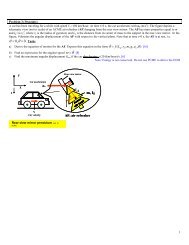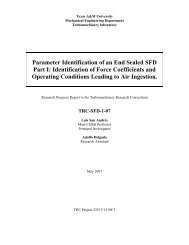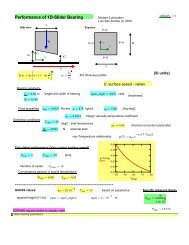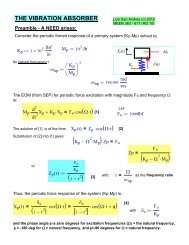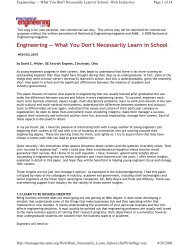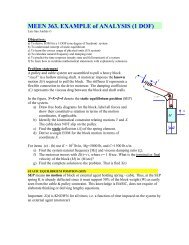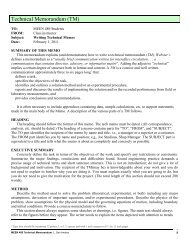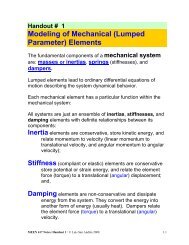Solving Problems in Dynamics and Vibrations Using MATLAB ...
Solving Problems in Dynamics and Vibrations Using MATLAB ...
Solving Problems in Dynamics and Vibrations Using MATLAB ...
You also want an ePaper? Increase the reach of your titles
YUMPU automatically turns print PDFs into web optimized ePapers that Google loves.
18<br />
<strong>MATLAB</strong> Code<br />
The <strong>MATLAB</strong> code is similar to that written for the unforced response system, except that there<br />
is an extra term <strong>in</strong> the derivative vector, which represents the force applied to the system.<br />
The <strong>MATLAB</strong> code is given below.<br />
function yp = forced(t,y)<br />
yp = [y(2);(((f/m)*s<strong>in</strong>(ω n *t))-((c/m)*y(2))-((k/m)*y(1)))];<br />
Aga<strong>in</strong> the problem is to be solved for ξ = 0.1. So, calculate the value of ‘c/m’, ‘k/m’ <strong>and</strong> ‘f/m’ by<br />
follow<strong>in</strong>g the procedure mentioned <strong>in</strong> the earlier example <strong>and</strong> then substitute these values <strong>in</strong>to<br />
the above expression. Save the file as ‘forced.m’.<br />
The follow<strong>in</strong>g code represents the ma<strong>in</strong> code, which calls the function <strong>and</strong> solves the differential<br />
equations <strong>and</strong> plots the required result.<br />
tspan=[0 5];<br />
y0=[0.02;0];<br />
[t,y]=ode45('forced',tspan,y0);<br />
plot(t,y(:,1));<br />
grid on<br />
xlabel(‘time’)<br />
ylabel(‘Displacement’)<br />
title(‘Displacement Vs Time’)<br />
hold on;<br />
Aga<strong>in</strong>, ‘tspan’ represents the time <strong>in</strong>terval <strong>and</strong> ‘y0’ represents the <strong>in</strong>itial conditions for y(1) <strong>and</strong><br />
y(2) which <strong>in</strong> turn represent the displacement ‘x’ <strong>and</strong> the first derivative of ‘x’. In this example<br />
the <strong>in</strong>itial conditions are taken as 0.02 m for ‘x’ <strong>and</strong> 0 cm/sec for the first derivative of ‘x’. Aga<strong>in</strong><br />
the default step size of the vector ‘tspan’ can be changed accord<strong>in</strong>gly as expla<strong>in</strong>ed <strong>in</strong> the<br />
previous example.<br />
To solve for different values of ξ, calculate the values of ‘c/m’ for each value of ξ. Substitute<br />
each value of ξ <strong>in</strong> the function file, which has the derivatives, save the file <strong>and</strong> then run the ma<strong>in</strong><br />
program to view the result.<br />
In the above code ‘y(:,1) represents the displacement ‘x’. To plot the velocity, change the<br />
variable <strong>in</strong> the plot comm<strong>and</strong> l<strong>in</strong>e to ‘y(:,2)’.<br />
The plot is attached below.






